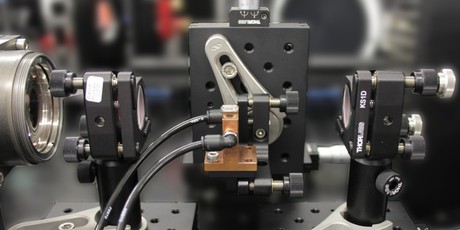Diamonds are a laser's best friend

Australian and German scientists have collaborated on the demonstration of a diamond laser that is said to be 20 times more powerful than previous diamond lasers. The researchers, from the MQ Photonics Research Centre and Germany’s Fraunhofer Institute for Applied Optics and Precision Engineering (Fraunhofer IOF), published their work in the journal Laser and Photonics Reviews.
Diamond is a relatively new material for creating laser beams, but it is rapidly becoming a technology leader in terms of generating powerful, high-brightness beams at wavelengths, or ‘colours’, where traditional lasers are not able to shine. High-power diamond lasers are particularly suited to applications that require beaming power over long distances, such as optical communications in space, laser ranging, and the tracking and removal of space debris.
“Just as X-rays pass through flesh to enable us to see bones within a body, different colours of laser radiation can interact or be transmitted by different target materials,” said Dr Robert Williams, the lead researcher on the project.
While average power levels are typically less than 20 W, the new diamond laser provides up to 380 W of output power — the equivalent of approximately 400,000 laser pointers and enough power to easily cut through steel. The wavelength of the laser, at 1240 nm, has high transmission through the atmosphere and is safer to use because of its reduced transmission through the front of the eye and lower risk of damage to the retina.
Diamond lasers have progressed enormously over the last few years due to advances in synthesis of high-quality diamond — better than what can be obtained naturally. As explained by Thomas Schreiber, group leader for the fibre laser research at the Fraunhofer IOF, “Diamond crystals seem to naturally fit to high-power fibre lasers. It’s interesting to see that such a development is now possible, and I’m sure much exciting research will follow.”
According to Dr Williams, the laser has penetrated so many aspects of industry, science and our daily lives that the number of applications is countless.
“A key to unlocking many more applications of lasers will be the development of high-brightness beams at new wavelengths,” he said, “and diamond is providing just that.”
Microplastics found to alter the human gut microbiome
Microplastic-treated cultures showed a consistent and significant increase in acidity (lower pH...
Sustainable, self-repairing, antimicrobial polymers developed
From medicine to electronics and optics, new materials developed by scientists at Kaunas...
A better way to create conductive polymers
New research disproves the longstanding belief that to create conductive polymers, substances...





